Car glazes are a really great product to use if you’re drying to achieve that glossy wet paintwork. But it’s important to know what they actually do, how to use them properly, and how they differ from products like waxes, sealants and polishes to really get the most out of them.
In this article, I’ll be going through all the common questions about glazes and give you everything you need to know. So let’s get started.
What is a Glaze?
Glazes cover and fill minor clear coat scratches and swirl marks in a car’s paintwork, giving it a glossier appearance. Glazes provide a temporary fix to clear coat paint imperfections, and should be applied before waxing with a soft foam or microfiber applicator.
What does a Glaze Do?
Glazes are designed to fill in minor imperfections in the clear coat. The result is a flatter surface, so light reflects more evenly creating a glossier appearance.
This creates a similar effect to polishing the paintwork, however they work completely differently to achieve this result.
First, let’s be clear about the imperfections that glazes aim to tackle.
The flatter the clear coat on your car, the shinier the paint will look. However, often the clear coats on most cars are not very flat at all and have imperfections including scratches and “swirl marks”. These create an uneven surface which light does not reflect off evenly.
Often, these clear coat scratches won’t be seen in normal lighting. However if you inspect the paintwork under bright light or in direct sunlight, you’ll see them very clearly.
Check out this diagram and photo.

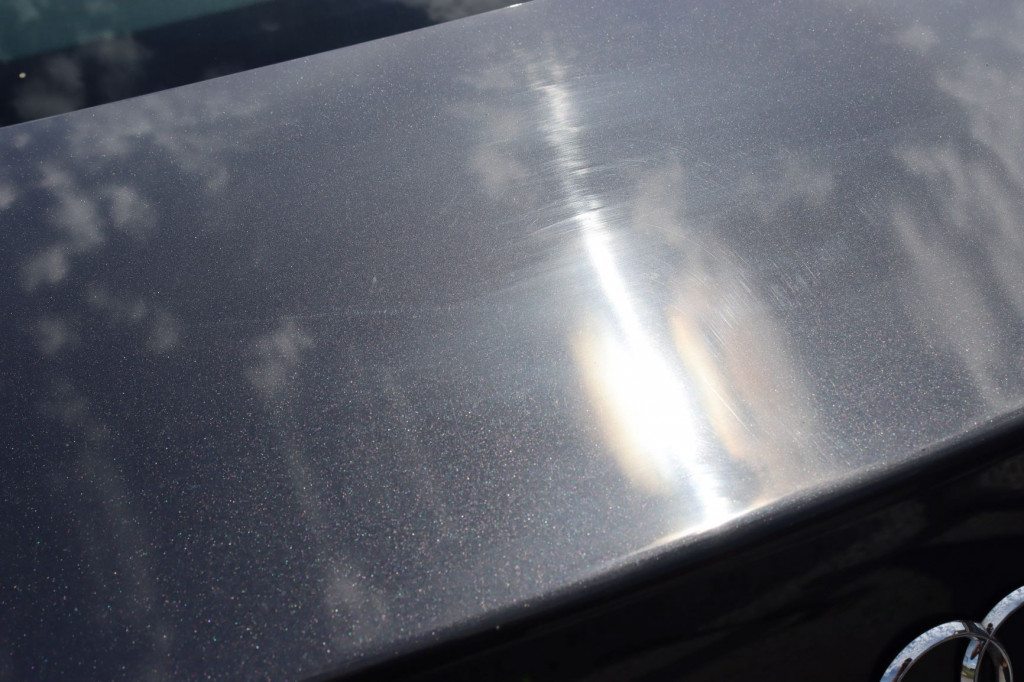
The scratches usually come from poor wash technique. For example, using a sponge or brush.
Check out this complete guide to washing your car without causing scratches.
These scratches look pretty ugly in direct light, and general give the paint an overall duller finish in all types of lighting. So if you want super shiny paintwork, you need to find a method to create a flatter clear coat.
This is where glazes can help.
How do Glazes Work?
Glazes contain fillers which essentially hide these clear coat scratches and swirl marks to create this flatter surface.
This provides a temporary fix, because once the glaze is removed, the scratches will be visible again.
Glazes don’t remove scratches permanently, they just cover them so they are less visible, creating the illusion of glossier paintwork.
Check out this diagram.
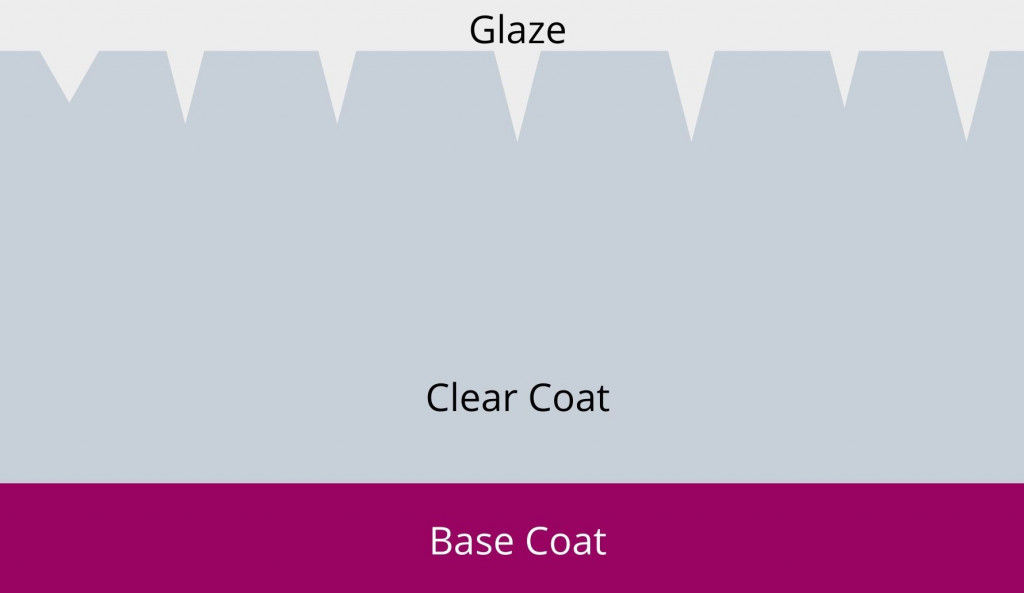
As you can see, the scratches are still present, but the surface that light is able to reflect off, is smooth and even. So the paint will look much glossier.
How Much Can They Hide?
So how much of a difference do glazes make then? And how much damage can they “fill in”.
Glazes only fill in minor scratches and swirl marks in the clear coat effectively.
Glazes do not cover the following types of scratches:
- Deep clear coat scratches
- Base coat scratches
- Primer scratches
Check out these pictures below. If the scratch you are trying to cover looks like this, then a glaze won’t work.
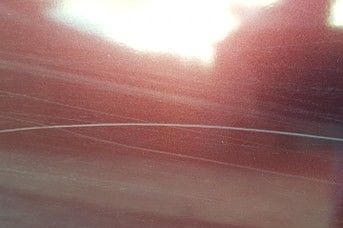

Your car’s paintwork has the following layers.

Glazes only work on clear coat scratches. And they are only able to hide minor scratches in this layer. Generally, they are used to give the appearance of glossier paint because they smooth out incredibly superficial scratches.
For example, if the car has been “clayed”, or compounded, then a glaze will help to even out the surface. However, it only covers very minor damage. So don’t expect miracles when you use a glaze.
The Application Process
There are two ways to apply a glaze to your car’s paintwork: by hand, or by machine. The overall process remains the same for each method:
- Apply the glaze thinly and evenly over the paint
- Wait for it to dry according to the manufacturer’s instructions (usually 5-10 minutes)
- Buff away gently using a soft, clean and plush microfiber towel.
It’s a very simply process that should only take around 20 minutes in total for the whole car.
If you’re applying the glaze by hand, then use a soft foam or microfiber applicator pad.
If you’re applying by machine, then you can use a dual action polishing machine. Do not use a rotary polisher, it will create too much heat and friction and can remove part of the clear coat.
Use a soft foam pad and a low-speed to apply the glaze evenly. Prime the pad first by covering it in a thin layer of the glaze, then add 3-5 drops to the pad to cover a section, for example, half the hood.
Remember, less is more with most products. Slapping on tonnes of product won’t help it fill more damage. So apply a thin and even layer for best results, and to make it easier to buff away the remaining excess.
If you really want to apply the glaze thoroughly, then you can use a second layer. However, it will not have a huge effect since the first layer is likely to have filled in most of the damage that it is able to.
When should you apply a glaze in the detailing process?
Glazes should be applied before applying any waxes or sealants to the paintwork. It’s a good idea to apply the glaze after thoroughly washing and chemically decontaminating (using iron fallout and tar removers) the surface for the best results possible.
You can also use a glaze after claying to help the fill in imperfections caused by the claying process.
Preparing the Paint for Glazing
Glazes should be applied underneath any paint protection e.g a wax. Glazes are best applied to bare paint that is squeaky clean.
If you want to maximise the durability of your glaze, then follow these preparation steps.
- Wash the car thoroughly.
- Use an iron fallout remover and tar remover spray if necessary.
- Clay the car (only if necessary) to remove any remaining contaminants.
- Wash the car again to remove any clay residue or loose contaminants.
- Strip any remaining waxes or sealants.
- Dry the car.
- Apply the glaze.
Following these steps ensures the paint is super clean before you apply it. This helps the glaze stick to the paint better and last much longer.
Glazes can be applied after just washing the car, and without stripping the wax and decontaminating, however, it will not last as long on the surface.
Take a look at this article I’ve written on the 5 best ways to safely remove old waxes and sealants to learn more about this process.
How Long Do Glazes Last?
This is a pretty common question people ask about glazes, but the answer isn’t completely straight forward and will depend on the following factors.
- Climate
- Where the car is stored
- How often the vehicle is driven
- How frequently the car is washed
- How well prepped the surface was
- The wax or sealant applied on top of the glaze
If you live in humid conditions or it rains frequently and the car is stored outside and driven daily, then the glaze will not last as long.
Also, if you wash the car frequently then the glaze will break down faster and be removed more easily. If you don’t apply a wax over the glaze, then it will be removed the next time you wash the car.
To extend the durability of the glaze, and protect the paintwork, you should apply a wax over the top. This helps to seal the glaze in.
However, keep in mind that applying a glaze underneath a wax will reduce the durability of the wax itself, because it is not able to bond to the actually paintwork.
This is more of an issue when using a sealant. If you apply a glaze underneath the sealant then the sealant cannot bond properly to the paint, which is very important to the application process.
It is still possible to apply a glaze underneath a sealant, but it will dramatically affect the durability. If you usually get a lifespan of 6-12 months when you apply the sealant to bare paint, it may only last around 3 months when applied over a glaze.
Usually, I would recommend applying a glaze underneath a wax compared to a sealant, because the durability issues are not quite as dramatic since waxes tend to mix better with other products.
Glazes on their own will last a couple of weeks. Whereas glazes applied underneath a wax or sealant usually last around 2-3 months before they need to be reapplied.
Glazes vs Polishes
Glazes and polishes are two detailing products that are very often confused. They have a similar effect, removing minor clear coat scratches so the paint looks glossier. However, the process by which this is achieved is very different.
Glazes cover scratches, and polishes remove them permanently.
Polishing the paint removes a layer of the clear coat to reveal a fresh, flat surface. This actually removes the scratches instead of just covering them.
Take a look at this diagram.
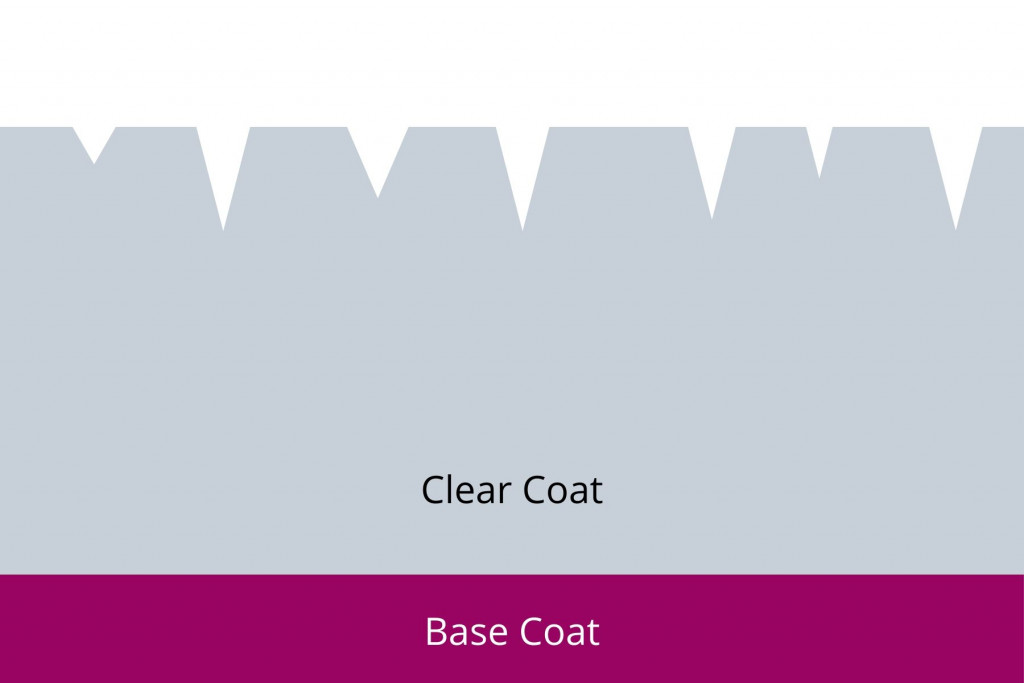
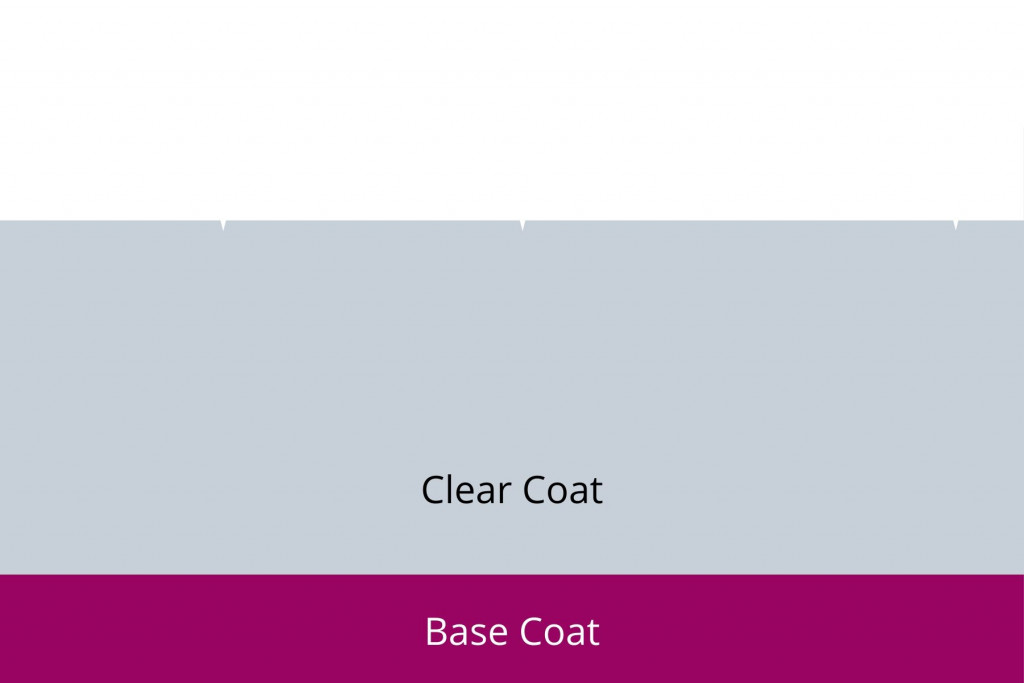
Glazes are a temporary fix, but a safer solution. They don’t remove the clear coat which helps to protect the paint from UV rays, corrosion and other forms of damage.
Polishes are a permanent fix, but they do come with some risks. Since you are removing the clear coat, you are removing a layer of the protection that it provides to the base coat (the colour).
You should try and preserve the clear coat if possible, to help protect the base coat underneath. That’s why glazes are very useful, because they provide a much safer solution to clear coat imperfections.
I’ve written a full article on glazes vs polishes so check it out if you want a more detailed comparison of the two products.
Glazes vs Sealants and Waxes
Glazes can also sometimes be confused with waxes and sealants as well. However, these two detailing products work very differently.
Waxes and sealants are not designed to cover minor clear coat imperfections. Instead, they are designed to protect the paintwork from dirt, UV rays, bird mess, iron fallout, tree sap etc.
This helps to preserve the clear coat and make it last longer.
Glazes do not have any protective properties. Instead, they are just designed to hide minor clear coat damage and make the paint look glossier.
Waxes and sealants can hide very minor clear coat imperfections and have some gloss-enhancing properties, but they are not as effective as glazes in this department.
You should always apply a wax, sealant or other form of paint protection to your car to help protect the clear coat. Glazes are more of a luxury to help boost the level of glossy. So if you could only choose one product, go with a wax or sealant instead of a glaze.
Take a look at this in-depth article I’ve written about the differences between waxes/sealants and glazes to learn more.
Pros and Cons
So now we’ve been through what glazes actually do, and how they are applied, let’s talk a bit about some of the pros and cons of this detailing product.
First, let’s start by going through exactly what glazes can and can’t do.
Glazes Can…
- Fill in very minor clear coat imperfections
- Create a glossier looking surface
Glazes Can’t…
- Permanently remove scratches
- Cover deep clear coat or base coat scratches
- Protect the clear coat
It’s important to keep this in mind to be able to judge a glaze fairly. They are simply designed to create glossier looking paintwork, not to permanently remove scratches, or protect the finish.
As well as understanding the limitations of glazes, it’s also important to consider the pros and cons of applying one to decide if they’re necessary for you.
Here is a quick table to show the advantages and disadvantages of using a glaze on your car.
| Advantages | Disadvantages |
| Quick and simple to apply | Do not last long on their own |
| Glossier and shinier paint | Reduce the durability of sealants/ waxes |
| Hide minor imperfections | No protective properties |
| Do not damage or remove clear coat | Only hides light swirl marks |
As you can see, the main issue with glazes is that they are not that durable, and they reduce the durability of the paint protection you apply on top.
It’s really a trade off. Do you want to have to maintain the vehicle more often to achieve glossier paint?
If the answer is yes, then go for a glaze. But if you don’t want to keep applying a glaze then a wax every 2-3 months, skip the glaze.
Should You Use A Glaze?
This brings us to the big question, should you use a glaze? In my opinion, there are two main scenarios where glazes are very useful.
- If the clear coat is too thin for polishing but has swirls and scratches that need hiding.
- If you don’t have time or confidence to correct the paint permanently.
If you fall into either of these categories, then glazes are a really effective solution.
However, keep in mind that it’s a temporary fix. If you actually want to remove the scratches and have truly perfect paint, then you’ll need to correct it instead by using a polish.
More Frequently Asked Questions
Don’t worry if you still have some more questions. Here’s a list of the most frequently asked questions on car glazes and how to use them.
How often should you use a glaze?
If you want to constantly have a glaze on your car, then you’ll need to reapply it every 2 months to ensure it still has an effect. You do not have to use a glaze this often though. Some car owners just use glazes before car shows to give the paint extra depth and gloss.
Should you wax before or after glazing?
You should apply a wax after a glaze, never before glazing. The wax should sit on top of the glaze to protect the paint properly, and help the glaze last longer.
What is the best glaze?
I’ve not tried every single glaze under the sun, but my personal favourite is Poorboy’s Black Hole. It’s a pretty inexpensive product but it’s really effective. It covers up swirls effectively and is very nice to use. It applies evenly, buffs off easily and smells great!
Thanks for reading! I hope you’ve found this article helpful. Don’t forget to check out the rest of the website to learn loads more about car detailing.

